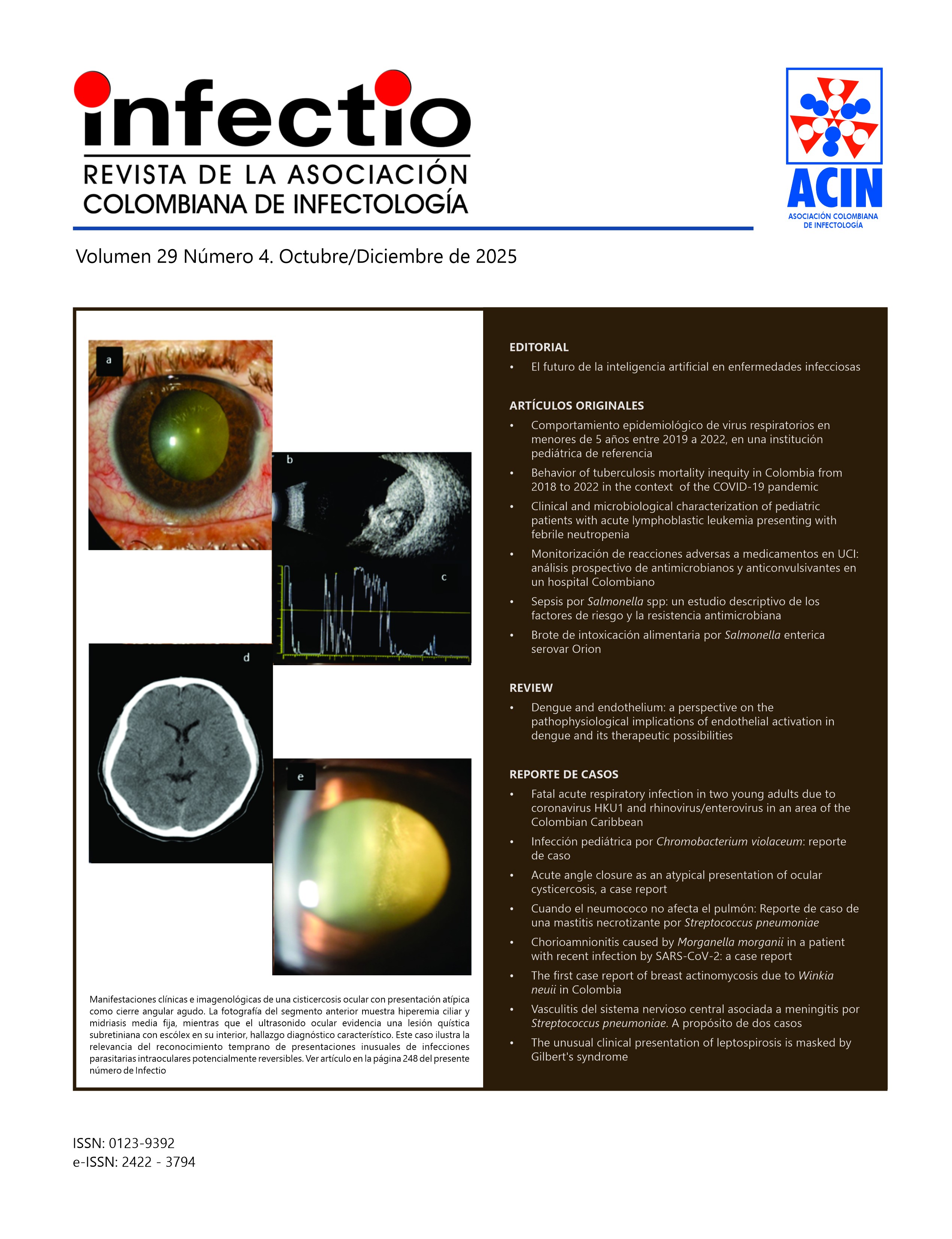Infección respiratoria aguda fatal en dos adultos jóvenes por coronavirus HKU1, y rinovirus/enterovirus en un área del caribe colombiano
Contenido principal del artículo
Resumen
Las infecciones respiratorias agudas causadas por coronavirus, adenovirus y rinovirus tienden a ser autolimitadas y afectan principalmente las vías respiratorias superiores en pacientes jóvenes, inmunocompetentes y sin antecedentes médicos. Sin embargo, en algunos casos, estos virus pueden volverse altamente virulentos. Este estudio describe dos casos de infecciones respiratorias agudas graves en pacientes de 19 y 18 años de una guarnición militar en el Caribe colombiano. Ambos pacientes no presentaban antecedentes clínicos relevantes y presentaron síntomas respiratorios agudos graves con una evolución tórpida que culminó en la muerte dentro de las 48 horas posteriores al ingreso. Inicialmente, los pacientes fueron tratados por síntomas asociados con el síndrome inflamatorio sistémico. Ambos pacientes presentaron infecciones respiratorias agudas mortales, y se detectaron coronavirus HKU1, rinovirus/enterovirus y adenovirus en ambos. Ambos pacientes fallecieron por shock cardiorrespiratorio. Los casos clínicos resaltan la importancia de la vigilancia epidemiológica en entornos concurridos, como cuarteles militares, y en el entorno donde vivían los pacientes, donde las infecciones respiratorias pueden propagarse fácilmente y promover la coinfección.
Detalles del artículo
Citas
Petat H, Schuers M, Marguet C, Humbert X, Le Bas F, Rabiaza A, et al. Positive and negative viral associations in patients with acute respiratory tract infections in primary care: the ECOVIR study. Front Public Health. 2023 Nov 24;11:1269805. PMID: 38074759; PMCID: PMC10706622. https://doi.org/10.3389/fpubh.2023.1269805
Leli C, Di Matteo L, Gotta F, Vay D, Piceghello A, Cornaglia E, et al. Prevalence of respiratory viruses by Multiplex PCR: a four-and-a-half year retrospective study in an Italian general hospital. Infez Med. 2021 Mar 1;29(1):94-101. PMID: 33664178.
Kong D, Zheng Y, Hu L, Chen J, Wu H, Teng Z, et al. Epidemiological and co-infection characteristics of common human coronaviruses in Shanghai, 2015-2020: a retrospective observational study. Emerg Microbes Infect. 2021 Dec;10(1):1660-1668. PMID: 34350810; PMCID: PMC8381891. https://doi.org/10.1080/22221751.2021.1965498
Instituto Nacional de Salud. Boletín Epidemiológico semanal No 39, 2024; semana 22-septiembre. Available from: https://www.ins.gov.co/BibliotecaDigital/2024-boletin-epidemiologico-semana-39.pdf [Accessed 2024 Oct 20]. https://doi.org/10.33610/23576189.2024.19
Fall A, Kenmoe S, Ebogo-Belobo JT, Mbaga DS, Bowo-Ngandji A, FoeEssomba JR, et al. Global prevalence and case fatality rate of Enterovirus D68 infections, a systematic review and meta-analysis. PLoS Negl Trop Dis. 2022;16(2):e0010073. https://doi.org/10.1371/journal.pntd.0010073
Tam CC, Anderson KB, Offeddu V, Weg A, Macareo LR, Ellison DW, et al. Epidemiology and transmission of respiratory infections in Thai Army recruits: A prospective cohort study. Am J Trop Med Hyg. 2018;99(4):1089-95. https://doi.org/10.4269/ajtmh.18-0219
Delmotte P-R, Monsel A. Neumonía viral grave en adultos. EMC - AnestesiaReanimación. 2024;50(1):1-15. https://doi.org/10.1016/S1280-4703(23)48663-X
Vaughn VM, Dickson RP, Horowitz JK, Flanders SA. Community-Acquired Pneumonia. JAMA. 2024. https://doi.org/10.1001/jama.2024.14796
Veiga ABG, Martins LG, Riediger I, Mazetto A, Debur MC, Gregianini TS. More than just a common cold: Endemic coronaviruses OC43, HKU1, NL63, and 229E associated with severe acute respiratory infection and fatality cases among healthy adults. J Med Virol. 2021;93(2):1002-7. https://doi.org/10.1002/jmv.26362
Millar EV, Schlett CD, Law NN, Chen WJ, D'Onofrio MJ, Bennett JW, et al. Reduction in Acute Respiratory Infection Among Military Trainees: Secondary Effects of a Hygiene-Based Cluster-Randomized Trial for Skin and Soft-Tissue Infection Prevention. Infect Control Hosp Epidemiol. 2016 Sep;37(9):1118-20. PMID: 27387422; PMCID: PMC5828161. https://doi.org/10.1017/ice.2016.154

